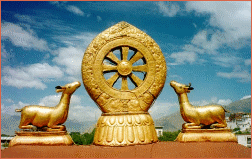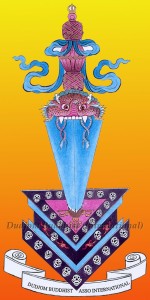Aims and Objectives on the Propagation of the Holy Dharma
- To bring about clarity on the authentic and genuine face of “Buddhism”, as well as on its goals of Dharma practice;
- To re-interpret the “Buddhist teachings” at much deeper levels by the using of “sciences”, modern concepts and terminology as footnotes;
- To train up Buddhist talents with experiences in both the study and practice of the Holy Dharma so as to help spreading the “Buddhist teachings”;
- To help modern Dharma practitioners with “right-to-the-point” training on actual “Dharma practices”;
- To provide Dharma practitioners with teachings and guidance on both the “study (of doctrines)” and “practice (actual Dharma practices)” of the Holy Dharma;
- To help train dying persons with “right-to-the-point” practical “guidance to escape from dangers, and to cope with adversities”.
“Dharma practice” is an “actual practice” for one to “learn how to handle one’s life, so that one can ultimately take control of one’s life with ease”.
It is only through in-depth teachings and analyses of the Buddhist Holy Dharma will enable the Buddhist followers to have a clear, vivid and real understanding of the authentic and correct Buddhist teachings, in order that the Buddhist followers will be well-informed through the three wisdoms of listening, contemplating and meditating on them, and then slowly come to truly understand the key points in their study and practice of the genuine and authentic Holy Dharma, resulting in the success of their own “Mind-Training and Dharma Practice”.
Tibetan Buddhism has a long history of more than one thousand years. Due to the fact that it has many different ways of Dharma practices, with a lot of rituals and ceremonies, it maybe a little bit exhilarating at the very beginning to the newcomers. But as time passes, some of those practitioners whose basic foundations in the Buddhist teachings are weak, or those whose intentions are impure, will soon found themselves to be frustrated or at a lost as to where they are and what they should adopt or abandon. In this regard, they will find that the more they practice the Dharma, the more they are confused as a result.
In receiving a lot of questions from among our readers and audience, as well as from the general followers of the Dharma, we have found that they complained a lot that it is not easy to cross the threshold of Vajrayana. And even when they have entered the door of Vajrayana, as it is so full and rich in various arrays of outward fascinations that it often distracts the eyes and confuses the minds. Hence, the more they go deeper and enter into the more inner dimensions towards the center of Vajrayana teachings, the more questions and difficulties they will encounter, even so much so that distorted conceptions and perceptions of Dharma practices start to arise.
All in all, these are long and winding roads with many twists and turns, just like a “maze”, and that it is usually much easier to get in, but it is very hard to get out, and is even more difficult to have a holistic view of what’s going on with a sense of direction. Then, how about all those skillful means, as well as the methods of liberation and perfect enlightenment within a single life-time, as were taught by Vajrayana?
These are usually all the “attractions” of Vajrayana, and yet they are sometimes quite confusing to a lot of Dharma practitioners, whether they are novice or long-time practitioners alike. In view of all these, our association has decided to put up various courses on the Three Yanas (that is, “Hinayana, Mahayana, and Vajrayana”) so as to introduce the basic concepts, fundamental principles and teachings, as well as the crucial points, distractions, misunderstandings, and even pitfalls in the practices of the Holy Dharma.
In so doing, we used the Vajrayana teachings as the frame of reference, the Mahayana teachings as the central theme, and the Hinayana teachings as the point of departure. For those practitioners who have already practiced the sadhanas for years but still have a lot of questions, as well as for those who have not yet correctly mastered the crux of the practices, these courses will serve as a useful guide. As “all practices are rooted in life itself”, and so how to practice, and how to maintain pure intention and awareness, in our daily life are the main focus of these courses, the contents of which touch upon the importance on the interplay and the interface of Dharma practice with our everyday life.
The series of courses on the training in both the study and practice of the Holy Dharma as offered by the Dudjom Buddhist Association (International) gave layers by layers of in-depth analyses and instructions on the various wisdom aspects of what Buddhism can offer to modern man. The viewpoints are very practical, extremely useful and innovative, and can help to integrate one’s “Dharma practices” with one’s own “daily living” in both flexibility and in-depth application. The various examples cited therein are most thought-provoking.
Even for an ordinary person who just wants “to have no regrets in one’s life, to achieve something in this very lifetime, and to avoid wasting time and being confronted with obstacles everywhere”, one simply cannot miss those important messages that have been put across in these courses.
We sincerely invite you all to enter the great door of the practical merits of Buddhism, so as to reorient one’s life, to redefine its meaning and to reposition oneself in it. If there are any merits and benefits to be gained from these series of courses, these will be totally dedicated to our Three Most Beloved Crowning Jewels (Root Gurus), namely: H.H. Kyabje Dudjom Jigdral Yeshe Dorje Rinpoche, H.H. Kyabje Chadral Sangye Dorje Rinpoche, and Ven. Lama Sonam Chokyi Gyaltsen, as well as to all our motherly sentient beings, as limitless as the sky!
SARWA MANGALAM!

